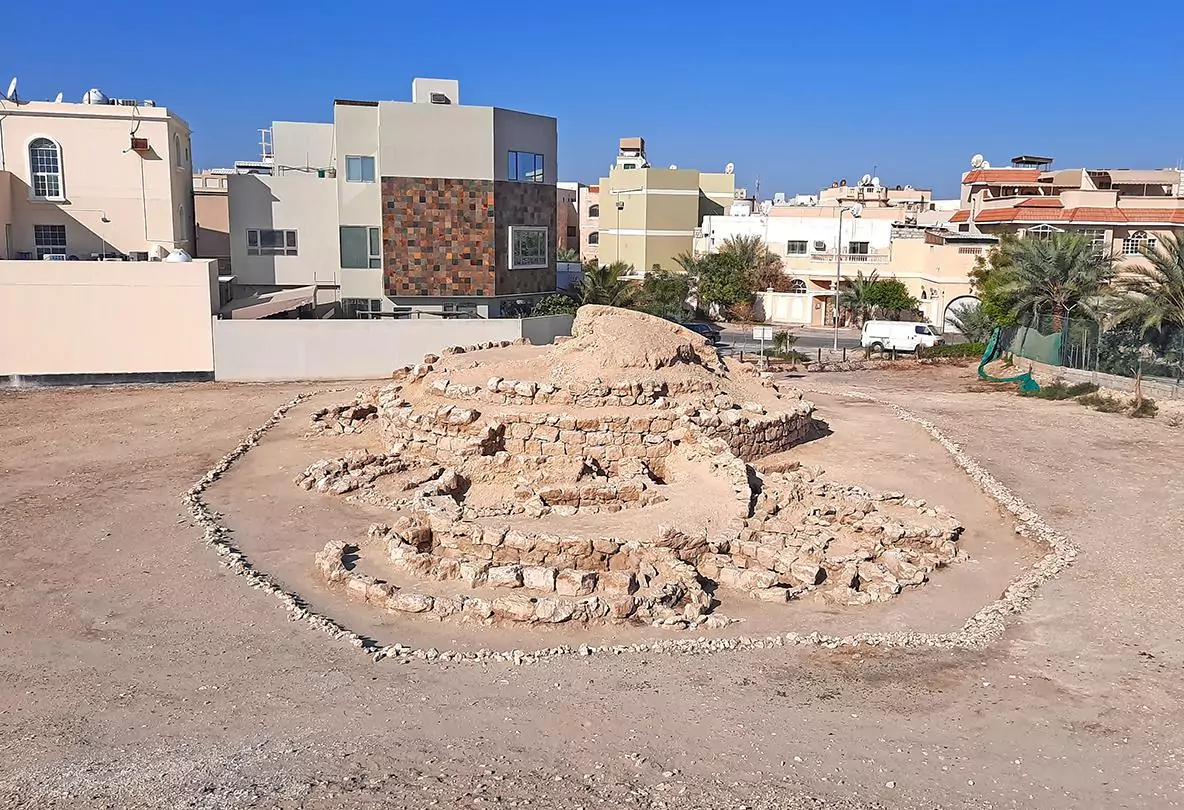The Dilmun Burial Mounds are a series of necropolis sites located on the main island of Bahrain. These mounds were built between 2050-1750 BCE by the Dilmun civilization, an ancient civilization that was based in the Arabian Gulf. The Dilmun Burial Mounds are considered to be one of the largest prehistoric cemetery complexes in the world and are considered to be a testament to the remarkable architectural skills of the Dilmun people.
The Dilmun civilization was a prosperous civilization that engaged in trade and commerce with other civilizations in the region, including the Mesopotamian civilization. They were known for their sophisticated bronze metallurgy and their mastery of shipbuilding and seafaring.The Dilmun Burial Mounds are divided into three main areas: the Northern Burial Mounds, the Central Burial Mounds, and the Southern Burial Mounds. The Northern Burial Mounds are the largest of the three areas and contain over 10,000 burial mounds. The Central Burial Mounds are the most significant in terms of historical and archaeological value and contain a number of royal tombs, including the tomb of the King of Dilmun. The Southern Burial Mounds contain a smaller number of mounds and are located near the ancient harbor of the Dilmun civilization.The burial mounds were constructed using stone and earth, and were typically round or oval in shape. They ranged in size from small mounds to large, elaborate structures. Some of the larger mounds were constructed using a series of concentric rings, with each ring representing a different stage in the construction process.
The Dilmun Burial Mounds were used to bury members of the Dilmun elite, including kings, queens, and other important figures. The mounds were typically used for multiple burials and were often reused over a period of centuries. The mounds contained a variety of grave goods, including pottery, jewelry, and other personal items that were buried with the deceased.
The Dilmun Burial Mounds were first excavated in the 19th century, and many of the tombs were looted during this time. The Bahraini government has taken steps to preserve the mounds and to prevent further looting, and the site was designated a UNESCO World Heritage site in 2019.
Today, the Dilmun Burial Mounds are a popular tourist attraction and an important archaeological site. The mounds provide valuable insight into the burial practices and social structure of the Dilmun civilization, and are a testament to the advanced architectural skills of this ancient civilization.
The Dilmun Burial Mounds are a remarkable archaeological site located in the Kingdom of Bahrain. This site includes several thousand burial mounds that were created by the Dilmun civilization during the Bronze Age, between 2050 and 1750 BCE. The mounds are of various sizes and shapes and were constructed to house the dead, along with offerings and other funerary objects. The site provides important insights into the beliefs and customs of the Dilmun people, as well as the social and economic structures of the civilization.The Dilmun civilization was a Bronze Age civilization that existed in the area that is now Bahrain, Qatar, and Kuwait. The civilization was known for its trading and maritime activities, and it played a key role in connecting the Mesopotamian and Indus Valley civilizations. The Dilmun people were skilled sailors and traders, and they maintained contacts with other civilizations in the region, including the Sumerians, Babylonians, and Assyrians.The Dilmun Burial Mounds are located in three separate areas in Bahrain: the northern part of the island, the central region, and the southern region. The mounds are spread over an area of about 25 square kilometers and are concentrated along the coast and near freshwater springs. The largest group of mounds is located in the northern part of the island, near the village of A'ali. This area contains more than 11,000 burial mounds, making it one of the largest prehistoric cemeteries in the world.The burial mounds vary in size and shape, with some being only a few meters in diameter, while others are several meters in height and up to 30 meters in diameter. The mounds were constructed using local materials, including sand, limestone, and coral. Many of the mounds have a central chamber that contains the remains of the deceased, along with offerings and other funerary objects. Some of the larger mounds also have external walls or chambers that were used to house the remains of other family members or to store offerings and other goods.
The Dilmun Burial Mounds provide important insights into the social and economic structures of the Dilmun civilization. The presence of large, elaborate burial mounds indicates that the Dilmun people had a highly organized society with a sophisticated system of beliefs and customs surrounding death and the afterlife. The mounds also suggest that the Dilmun people had a hierarchical society, with some individuals and families having greater resources and influence than others. The fact that the mounds are concentrated along the coast and near freshwater sources suggests that the Dilmun people placed a high value on access to water and that water may have played an important role in their economy and social organization.The Dilmun Burial Mounds were first identified by European explorers in the 19th century, and the site was excavated by a number of archaeologists during the 20th century. The site was recognized as a UNESCO World Heritage Site in 2019, in recognition of its outstanding universal value and the importance of its cultural and historical significance.In addition to the burial mounds, the site also includes a number of other archaeological features, including ancient settlements, temples, and other structures. These features provide further insights into the social and economic structures of the Dilmun civilization and the ways in which the people lived and worked. The Dilmun Burial Mounds are an important archaeological site and a testament to the rich cultural heritage of Bahrain and the wider Middle East region.






0 Comments